History
Potter County was established in 1804, carved from the northwestern part of Lycoming County, and named in honor of General James Potter, a Revolutionary War hero. Although General Potter never set foot in the area, his legacy lives on in this rugged and beautiful part of Pennsylvania. Nestled along the northern border of the state, Potter County is known for its abundant natural resources, most notably its vast forests.
In the early 1800s, this densely wooded region was sparsely populated. Native Americans passed through but did not settle in significant numbers. In 1808, the opening of an east-west road across northern Pennsylvania brought the first wave of settlers, though life in the wilderness was harsh, and only the hardiest made their home here. It wasn’t until the mid-19th century, when the area’s towering white pines, hemlocks, and hardwoods drew lumbermen from places like Maine and Canada, that the population began to grow.
By the late 1800s, Potter County had become a thriving center for the lumber industry. Sawmills sprang up along the county’s rivers and streams, and railroads were built to transport the timber to markets in the east. Towns such as Galeton, Austin, and Cross Forks flourished as the demand for lumber surged. Laborers from Europe and other parts of the U.S. moved in to meet the need for workers, and by 1900, Potter County’s population reached an all-time high of 30,621.
However, this boom was not to last. As the forests were stripped bare and the timber industry declined, many people left the area. Much of the deforested land was abandoned and eventually reverted to the Commonwealth of Pennsylvania. Today, over 40 percent of Potter County—nearly 300,000 acres—is public land, managed as state forest.
Although the county’s population has diminished significantly since its peak in 1900, Potter County has transitioned into a new era. Farming, lumbering, tourism, and recreation have become the mainstays of the local economy. The forests that were cut down a century ago have largely regrown, with new generations of hardwood trees now covering the hillsides. These natural assets, combined with the county’s rich history and scenic beauty, continue to define Potter County.
Known as “The Roof of Pennsylvania,” Potter County is the source of several major watersheds, feeding into the Ohio/Mississippi River system, the Chesapeake Bay, and the St. Lawrence River. Today, Potter County remains a place where nature, history, and community converge, offering residents and visitors alike a glimpse into both its storied past and promising future.
Historical Nuggets
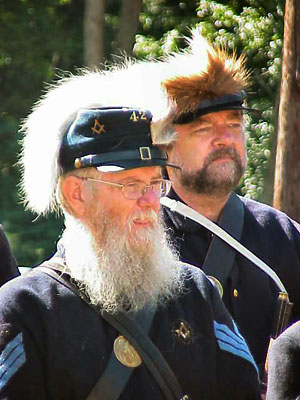 Much has been written about the colorful 42nd Regiment, First Rifles of the Pennsylvania Reserves. They were sometimes referred to as the Bucktailed Wildcats. Their skill as marksmen and frontier background gave them an advantage on the battlefield as soldiers in the Army of the Potomac.
Much has been written about the colorful 42nd Regiment, First Rifles of the Pennsylvania Reserves. They were sometimes referred to as the Bucktailed Wildcats. Their skill as marksmen and frontier background gave them an advantage on the battlefield as soldiers in the Army of the Potomac.
Volunteers from the Pennsylvania Wildcat region – roughly bounded by today’s McKean, Cameron, Potter and counties – answered the call to serve in the Bucktails, under the leadership of General Thomas L. Kane. They were distinguished from other soldiers by the tail of a whitetailed deer attached to the back of their hats as a symbol of unity and a badge of marksmanship.
Historian Murray Neeper says the deer tail served another important purpose. As the affiliations and assignments of the original volunteers changed, it is the one identifying characteristic that has stood the test of time. Today, because of that tail, historians and descendants have a fairly clear idea of what happened to most of the soldiers who left the mountains in 1861 to serve their Union and save their flag.
Many Bucktails were heroes of the Civil War, Neeper points out, as the regiment played a critical role in important battle victories, including Gettysburg. He attributes their effectiveness to the leadership skills of General Kane, as well as the mental and physical toughness of the volunteers.
Coudersport Glass still found today
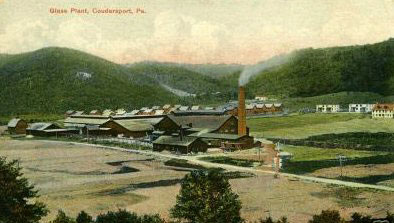
Water pitchers, vases, salt and pepper shakers, candy dishes and other examples of Coudersport Glass still surface from time to time at yard sales, flea markets, antique shops and estate sales. Some of the pieces are on display at the museum of the Potter County Historical Society in Coudersport.
They’re the results of a twist of fate when the paths of two international glassmaking legends intersected in Potter County.
With an abundance of natural gas and rich sandstone and water resources, Coudersport seemed a natural location for glass manufacturing. Two members of the famous Webb family from England, brothers Joseph and H. Fitzroy Webb, opened a glass tile factory in the Mill Creek valley, just east of the business district in an area now referred to as Center Park.
Webb Patent Tile Company began production in late 1900. The factory had a separate division, the Joseph Webb Decorative Glass Company.
 A distinctive pea vine, or endless vine, pattern was molded or painted onto many of the vases and dishes.
A distinctive pea vine, or endless vine, pattern was molded or painted onto many of the vases and dishes.
With tile sales flat, the brothers focused entirely on glassware, which by then included paperweights and other novelty pieces. Sales did not meet the owners expectations and production ground to a halt in May 1901.
Two years later, another knowledgeable glassmaker, Harry Bastow, reopened the Webb plant to produce an expanded line of ornamental glass. Among those arriving with Bastow were brothers Frank L. Fenton and John W. Fenton.
Frank Fenton managed the decorating department, long before the family name was associated with one of the world’s most famous lines of glassware. Sales were encouraging and marketing was extended beyond Potter County’s borders.
On the night of Sunday, May 8, 1904, fire erupted near one of the cellar furnaces. Fanned by a strong southeasterly wind, the flames roared through the building.
Underinsured and unable to raise the necessary capital to rebuild, Bastow and the Fentons left town, never to return.
Potter County’s most famous resident
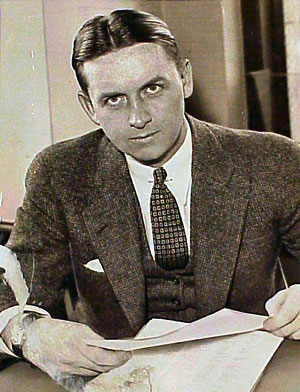
How did Eliot Ness end up in Potter County?
Two decades after serving as a federal agent, part of a team charged with ridding Chicago of menacing crime figures epitomized by Al Capone, Ness was board chairman for Diebold, a leading manufacturer of safes, vaults and financial services equipment. He also partnered with Major General Claire Lee Chennault, of Flying Tigers fame, in the operation of an export/import company.
By the time he arrived in Coudersport in 1956 with his wife and son, Ness was fighting what proved to be a losing battle as an officer of the North Ridge Industrial Corporation.
North Ridge was an umbrella for two subsidiaries: Guaranty Paper Company and Fidelity Check.
Ness was brought into the inner circle at North Ridge for whatever name recognition and connections he might lend to the endeavor.
North Ridge moved from a plush Cleveland office complex to downtown Coudersport in 1956. Officers met with the local business community, seeking financial support for a production plant and an ambitious marketing plan.
Why Coudersport?
The answer is twofold.
North Ridge, which was running in the red, needed a location where it could get a fresh start. Coudersport fit the bill with a large unskilled labor pool and a lower cost of living. Secondly, two of its officers had developed financial connections in Potter County through the natural gas and mining industries.
North Ridge/Guaranty Paper advertised in leading financial publications, hoping to attract business for watermarked checks with an added innovation: an endorsement line on the front. This was hailed as a time-saver for bank tellers. The company also planned to print checks with pictorial backgrounds, forerunners of the vanity checks that would become so popular a couple of decades later.
Many community leaders and investors from the Coudersport area purchased stock in North Ridge. Two local banks provided loans.
However, orders for watermarked checks were few and far between. The company could scarcely meet its payroll obligations. Divisions among the company’s executive management deepened and bankruptcy loomed.
By that time, Eliot Ness was working with professional writer Oscar Fraley on a book that sensationalized his battles against the Capone outfit in Chicago. He was diagnosed by Coudersport physician Dr. George Mosch with a heart condition and advised to avoid stress. He was also prescribed a sedative.
Fraley recognized the potential gold mine that Ness’s exploits presented to an enterprising writer. He met with Ness on several occasions at the Hotel Crittenden to review scrapbooks and flesh out more details of the brewery raids and other enforcement actions. When Ness’s memory failed him, Fraley filled in the blanks with his own vivid imagination for a book to be titled The Untouchables.
The premise behind the title, originally coined by a Chicago newspaper editor, was legitimate. Ness had shown courage and determination in battling Al Capone’s forces, refusing bribes and cutting into the crime outfit’s economic lifeblood by raiding and destroying breweries.
On May 16, 1957, Eliot Ness died of a heart attack in his Coudersport home. He was 53. Within weeks of his death, his widow and son moved back to Cleveland.
Coudersport’s two banks foreclosed on the loans, while the Internal Revenue Service stepped in, freezing the North Ridge’s assets. Investors sued, but were unable to recover their losses.
“The Untouchables” enjoyed modest success, but the book attracted the interest of television and movie producers who further distorted the story of Eliot Ness versus Al Capone to create a Hollywood legend.
Ness’s descendants sold their rights to Fraley for a modest sum and did not profit from the exploitation that made him a figure of international fame.
Two theaters operate in Potter County
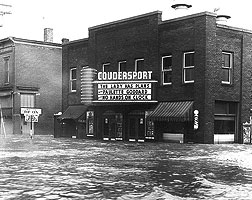
Small-town movie theaters have, by and large, gone by the wayside. But there are two of them in Potter County. One of them is relatively new, established in a former church in the Borough of Galeton, overlooking Berger Lake. The second is a true survivor the Coudersport Theatre (coudersporttheatre.com).
Judy Bolton books born in Potter County

Each October, the writings of Potter County author Margaret Sutton are celebrated during the annual Judy Bolton Days. Visitors tour sites in the county that were the basis for many adventures by the girl detective, Judy Bolton.
 Sutton’s book series has endured because of her ability to weave into the adventure stories elements of allegory, social commentary and other interesting twists. The books enjoyed national popularity and the lead character was a role model to countless young girls.
Sutton’s book series has endured because of her ability to weave into the adventure stories elements of allegory, social commentary and other interesting twists. The books enjoyed national popularity and the lead character was a role model to countless young girls.
Margaret Sutton (shown) was the pen name of Rachel Beebe, who was born in Potter County on Jan. 22, 1903, and died on June 21, 2001. More information is available at judybolton.com.
County Historical Buildings
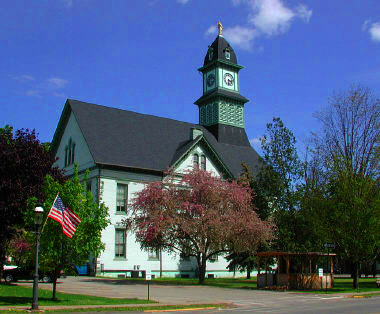 Potter County Courthouse, often referred to as the jewel of Coudersport, is listed on the National Register of Historic Buildings. It was built in 1851-53 by contractor William Bell of Warren and carpenter Eli Rees, at a cost of about $17,000.
Potter County Courthouse, often referred to as the jewel of Coudersport, is listed on the National Register of Historic Buildings. It was built in 1851-53 by contractor William Bell of Warren and carpenter Eli Rees, at a cost of about $17,000.
The courthouse is an example of Victorian architecture. Its Greek Revival style and prominent location in the open town square create a stately appearance, appropriate to the building’s role in the political life of the county.
Alterations were made in 1888-89, including relocation of the courtroom from the first floor to the second. Contractor was Home Hall of Olean. N.Y., who also built the Coudersport Consistory.
During the winter of 1933-45, through the Civil Works Administration, Potter County was able to renovate the courthouse. The basement was excavated for establishment of additional office space. Concrete footing was placed under the old walls. The entire interior and exterior were repainted and modern conveniences were added.
A cupola clock keeps time for the town. It was a gift of Henry Hatch Dent. A courthouse bell was donated by the Hon. Timothy Ives.
Atop the clock tower is a statue of justice. The statue is a plastic replica of the original, which is on display in the courthouse lobby.
Even so, the building could no longer meet the county government’s space demands and several functions were located in rental units.
Prior to construction of today’s courthouse, a building constructed in 1835 to accommodate court proceedings and other county functions was disassembled. Its stone foundation was moved across Second Street to become part of the Potter County Jail.

History of F. W. Gunzburger County Office Building

What is now referred to as the F. W. Gunzburger County Office Building at the corner of Main and Water streets served for several decades as a center of education in the Potter County seat of Coudersport.
The 57,000 square foot building actually has its roots in two separate schools that occupied the same lot in the early 1900s.
What was once the Coudersport Elementary School (or Grade School) faced First Street. Charming reminders of that era can still be seen with the prominently marked Boys and Girls entrances on the north side of the Gunzburger Building.
A separate Coudersport High School on the same block faced Main Street. Expansion in the early 1930s linked the two school buildings and, soon, the students had a gymnasium. Another addition on the West Street side in the late 1950s accommodated a cafeteria.
Most of the smaller communities in what is now the Coudersport Area School District had their own schools, many of them of the one-room variety. Consolidation brought an increase in the number of students and space limitations.
When the present-day Coudersport Area Junior-Senior High School was built in the early 1960s, the building became solely the Coudersport Elementary School. It served the community well, but physical modifications required to meet new regulations were too expensive for the school district to pursue. A new elementary school was built in 1987 and the former school was put up for sale.
Its deteriorating physical condition and the need to remove deadly asbestos limited potential buyers interest. Finally, Adelphia Communications Corp. purchased the property.
Major renovations followed before Adelphia, which was experiencing rapid growth as a TV cable company, relocated several of its corporate operations to what was renamed the Rigas School Building.
In 2002, Adelphia came under Chapter 11 bankruptcy protection. Eventually, Adelphia’s Coudersport assets were sold to Time Warner Cable. It wasn’t long before that company pulled its functions out of Potter County.
As stressful as these developments were for the community, one bright spot was Time Warner’s willingness to donate the property an asset valued in the millions of dollars to the people of Potter County.
Who Was F. W. Gunzburger?
F. W. Gunzburger: A Life of Service
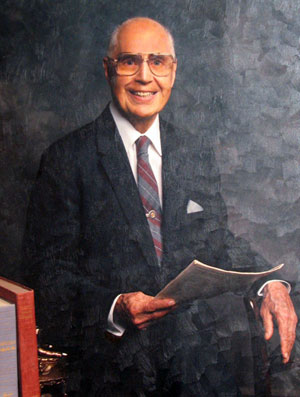
For more than 70 years, Coudersport’s Ferdinand Wile Gunzburger was the epitome of public service. During his tenure as a county official a longevity record unequaled in Pennsylvania history Gunzburger was an inspiration to countless others through his pleasant demeanor, his positive attitude, strong work ethic, healthy lifestyle and dedication to helping others.
The majestic courthouse in the middle of Coudersport’s town square became F.W. Ferdy Gunzburger’s second home in 1928 when he was appointed Chief Clerk for the Board of County Commissioners. He remained in position until he retired on Jan. 1, 1993.
A test of Gunzburger’s mettle came after the Great Depression in 1933. As Director of the Emergency Relief Board, he found work for upwards of 1,500 unemployed people. Streets were paved; renovations were made to churches, the hospital, and government buildings; an athletic field was renovated and wood was cut and delivered to needy families.
As counties burdens grew, Gunzburger found himself holding down more titles than any other county official in the state. He accepted these added roles public welfare director, veterans affairs director, chief tax assessor, director of elections and chief voter registrar so that the county taxpayers would not be burdened with additional employees on the payroll.
He was admired far and wide for his ability to instantly cite statistics, statutes, individuals and events. Auditors frequently commended Gunzburger for his investment abilities with county revenues. Any number of Potter County residents who came upon hardships benefited from Ferdy’s quiet charity and words of encouragement.
At his funeral in 2002, several speakers remarked that they had not once heard him utter an unkind word about another.

 It was built in 1922-23 at a cost of about $25,000. It opened its doors on Jan. 16, 1923. The distinctive curtain (shown) was installed in 1928. It depicts the legendary Spanish knight Amadis de Gaula on the left, and Spanish dancers beneath the mystic blossoms of a tree on the right. The two sides portray contrasting dramatic and philosophical ideals that can be found in every culture in every generation.
It was built in 1922-23 at a cost of about $25,000. It opened its doors on Jan. 16, 1923. The distinctive curtain (shown) was installed in 1928. It depicts the legendary Spanish knight Amadis de Gaula on the left, and Spanish dancers beneath the mystic blossoms of a tree on the right. The two sides portray contrasting dramatic and philosophical ideals that can be found in every culture in every generation.